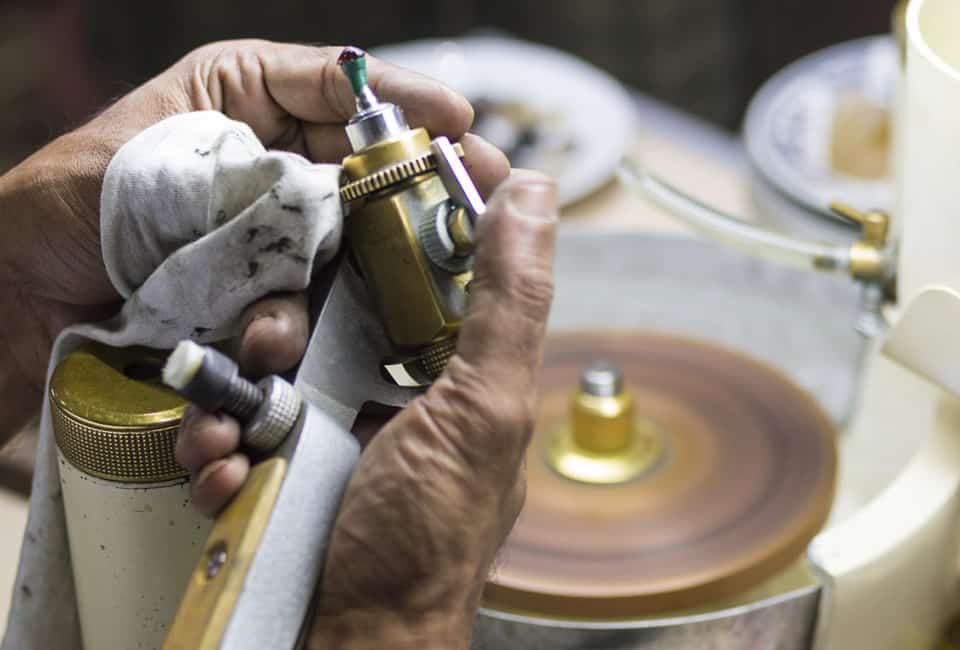The gem extracted from the earth gets its beauty and the value only when they are properly cut and polished. There-fore the lapidary industry is as old as are of gem mining in Sri Lanka. Until early 1970s, cutting and polishing of gems were performed using a traditional machine called Hanap-oruwa. Gem cutting machinery too have improved vastly from ancient Hanaporuwa to modern faceting machines with many accessory machinery for calibrating, Sawing and performing etc being employed. Satisfying the modern day requirements of the jewellery industry would never have been feasible with Hanaporuwa type machines since only cut and polished stones were -allowed to be exported, many new lapidaries were started to cope with the topaz rush. The opportunities available for gem cutting as employment increased the demand for training facilities and hence many institutions increased their training capabilities.
The reputation of the Sri Lanka lapidary and the low cost of labour during the last three decades have increased the demand for service cutting of calibrated stones. The value addition per carat in the calibrated stone industry is estimated to vary between 25-30% for imported stones and 40-100% for local stones. It is estimated that there are around 20,000 cutters in Sri Lanka of which about 5000 are employed in the diamond cutting factories. They process both precious and semi- precious gemstones in free sizes and calibrated sizes.
Precious Gem Cutting Sri Lanka is considered the fastest developing gem cutting and finishing center in the world, producing stones as small as 1/3 of a millimeter with zero or very low tolerance according to technical drawings supplied by the customers. Currently Sri Lankan Gem Cutting factories are catering to a highly prestigious clientele in the watch and jewellery industry such as Rolex, Mont Blanc, Bvlgari, Cartier, Tiffany & Co. etc.
Sri Lanka has signed along with 41 other countries, the Kimberly Process Agreement (KPA) under KPA, diamond mining, processing and trading countries have agreed to establish legislature to eliminate trade in ‘conflict diamonds’ the term ‘conflict diamond’ is used for diamonds, sales of which are used to finance weapons and machinery in countries where there are conflicts between the legitimate governments and opposing parties.
Jewellery Industry
The jewellery manufacturing industry at present employs approximately 15,000 persons of which around 10,000 are registered individual craftsmen while the rest is employed in factories and workshops producing jewellery mainly for the export market. There may be around 1,500 unregistered employees working under registered craftsmen.
About 60% of the jewellery workshops and craftsmen are located mainly in the rural areas of Southern and.Central provinces and in pockets in the North Western, Eastern and Northern provinces. 30% and 10% of jewllery workshop are located in suburban and urban areas respectively.
The jewellery manufacturing industry in Sri Lanka mainly consists of three sectors such as manufacturing for exports, local market and tourists’ trade.
Sri Lanka’s main markets for jewellery are Japan, Germa-ny, USA, UK, Singapore and Hong Kong. During recent times, silver jewellery studded with semi- particularly moonstones and low quality precious stones have gained popularity. A large number of traditional jewellery have adapted themselves to producing modern designs particu-larly for the German market.
Jewellery design and manufacturing have undergone a lot of changes during the past few decades. The use of comput-er software to create modern designs and casting jewellery for bulk production has come to play a major role in the jewellery industry.

